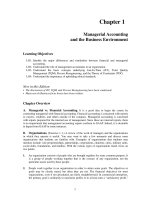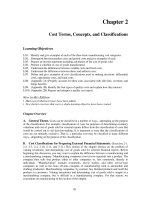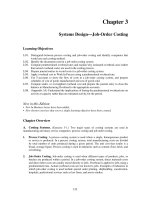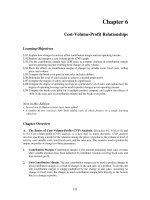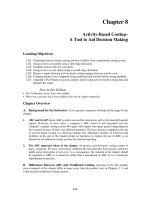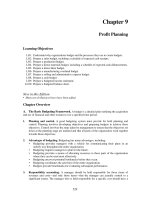Overview managerial accounting chapter 012
Bạn đang xem bản rút gọn của tài liệu. Xem và tải ngay bản đầy đủ của tài liệu tại đây (3.89 MB, 102 trang )
Chapter 12
Segment Reporting and Decentralization
Learning Objectives
LO1. Prepare a segmented income statement using the contribution format, and explain the
difference between traceable fixed costs and common fixed costs.
LO2. Compute return on investment (ROI) and show how changes in sales, expenses, and
assets affect ROI.
LO3. Compute residual income and understand the strengths and weaknesses of this method
of measuring performance.
LO4. (Appendix 12A) Determine the range, if any, within which a negotiated transfer price
should fall.
New in this Edition
• This chapter has been extensively rewritten.
• Many new In Business boxes have been added.
• Additional exercises have been written.
Chapter Overview
A. Responsibility Accounting. Responsibility accounting is concerned with designing
reports that help motivate managers to make decisions and to take actions that are in the best
interests of the overall organization.
1.
The benefits of decentralization. In a decentralized organization, decision making is not
confined to a few top executives, but rather is spread throughout the organization.
Responsibility accounting functions most effectively in an organization that is
decentralized. A number of benefits result from decentralization.
a. Top management is relieved of much day-to-day problem solving and is left free to
concentrate on strategy, higher-level decision-making and coordinating activities.
b. Lower-level managers generally have more detailed and up-to-date information about
local conditions than top managers. Therefore, lower-level managers are often capable
of making better operational decisions.
c. Delegating decision-making authority to lower-level managers enables them to quickly
respond to customers.
755
d. Decentralization provides lower-level managers with the decision-making experience
they will need when promoted into higher-level positions.
e. Delegating decision-making authority to lower-level managers often increases their
motivation. The end result can be increased job satisfaction and employee retention, as
well as improved organizational performance.
2.
Disadvantages of decentralization. Particularly in larger organizations, the benefits of
decentralization usually outweigh the disadvantages. Nevertheless, it is important to be
aware of the potential problems with decentralization.
a. Lower-level managers may make decisions without fully understanding the “big
picture.” While top-level managers typically have less detailed information about local
operations than the lower-level managers, they usually have more information about
the company as a whole and should have a better understanding of the company’s
strategy.
b. In a truly decentralized organization, there may be a lack of coordination among
autonomous managers. This problem can be reduced by clearly defining the company’s
strategy and communicating it effectively throughout the organization through the use
of a well-designed Balanced Scorecard (see Chapter 10).
c. Lower-level managers may have objectives that are different from the objectives of the
entire organization. For example, some managers may be more interested in increasing
the sizes of their departments than in increasing the profits of the company. To some
degree, this problem can be overcome by designing performance evaluation systems
that motivate managers to make decisions that are in the best interests of the company.
3.
Investment, Profit, and Cost Centers. There are at least three types of responsibility
centers.
a. A cost center manager has control over cost. Cost center managers are evaluated based
on how well costs are controlled, given the level of activity.
b. A profit center manager has control over both cost and revenue. Profit center managers
are usually evaluated based on performance relative to profit targets.
c. An investment center manager has control over cost and revenue and also has control
over the use of investment funds. Investment center managers are usually evaluated
based on rate of return on investment (ROI).
B. Segmented Reporting. (Exercises 12-1, 12-5, 12-7, and 12-8.) To operate effectively,
managers need a great deal more information than is provided by a single, company-wide
income statement. Income statements are needed that focus on segments of the company.
1.
Segments. A segment is any part or activity of an organization about which a manager
seeks cost or revenue data. Examples of segments include sales territories, manufacturing
facilities, service centers, individual products, and individual customers.
756
2.
Segmented statements. Segmented statements can be prepared for activity at many
different levels in an organization. Exhibit 12-2 in the text illustrates three levels of
segmented statements.
3.
Sales and contribution margin. Sales for each segment should be identified along with
variable costs, resulting in a contribution margin. The segment contribution margin is
especially valuable in decisions that involve the use of excess capacity.
4.
Traceable vs. Common Fixed Costs. Whether a fixed cost is assigned to a segment should
depend on whether it is traceable to that segment or is a common cost. A cost may be
traceable to one segment and common to another.
a. Traceable Fixed Costs. Traceable costs arise because of the existence of a particular
segment. If a cost is avoidable if a segment were discontinued, then it is a traceable
cost of that segment.
b. Common Fixed Costs. A common fixed cost is a fixed cost that supports more than
one business segment, but is not traceable in whole or in part to any one of the business
segments. A fixed cost that is common to a particular segment would continue even if
that particular segment were discontinued. Since common costs are not avoidable costs
of the segment, they should not be considered costs of the segment for purposes such as
product drop decisions or pricing. Of course, it is always possible to arbitrarily allocate
any cost—including common fixed costs—among segments. However, if common
costs are allocated among segments, the resulting segment statements are potentially
very misleading and erroneous decisions may result. For example, a manager might
drop a segment that appears to be operating at a loss, only to discover later that the
common fixed costs that were arbitrarily allocated to the segment do not disappear and
are simply reallocated to the remaining segments.
c. Do common costs exist? There is a great deal of disagreement about what costs are
and are not traceable to segments.
•
Some people allege that essentially the only costs traceable to products are direct
materials whereas others assert that all costs can be traced to products. That is, some
commentators believe almost all costs are common with respect to products whereas
others believe there are no common costs at all. (For example, the early ABC literature
implicitly assumed common costs do not exist.) Our belief is that the truth lies
somewhere in the middle—a lot of costs can be traced to products but by no means all
costs. The illustrations in the text and in the exercises, problems, and cases reflect that
belief.
•
Cooper and Kaplan, the leading architects of activity-based costing, have advocated a
system of segmented reports that is very much in the spirit of what we recommend in
this chapter. They define a hierarchy of costs in which costs can be usefully aggregated
upwards but should not be allocated downwards. Essentially, costs at each level of the
hierarchy are common to the activities carried out lower down in the hierarchy. For
example, they advocate that facility-sustaining costs, which are common to products,
should not be allocated to the products. (See Cooper and Kaplan, “Profit Priorities from
Activity-Based Costing,” Harvard Business Review, May-June 1991, pp. 130-135.)
757
•
With so much disagreement among the experts concerning which costs can and cannot
be traced to products, it should not be surprising that there is a great deal of uncertainty
in practice concerning whether a particular cost is traceable or not. The text and
problem material have been carefully worded to eliminate this sort of ambiguity. The
introductory course does not seem to us to be the most appropriate place to grapple
with all of the complexities of this issue.
d. What is common and what is traceable depends on the segment. A cost that is
traceable to a segment may not be traceable when the segment is further divided into
smaller segments. The salary of the vice president of the automotive products division
is a traceable cost of the segment “automotive products division” but it is not a
traceable cost of any particular product that is sold by the division. This is true even if
someone were to keep track of how much time the vice president devotes to each
particular product.
5.
Segment Margin. The segment margin is obtained by deducting the traceable fixed costs
of a segment from the segment’s contribution margin. The segment margin indicates how
much the segment is contributing toward covering common costs and towards profits.
C. Return on Investment (ROI) for Measuring Managerial Performance.
(Exercises 12-2, 12-6, 12-9, 12-10, 12-11, and 12-13.) Investment centers are usually evaluated
based on some measure of the rate of return on investment; that is, some measure of profits
divided by some measure of investment. This presumably provides incentives to increase profits
while controlling the amount of funds tied up in an organization.
1.
The definition of ROI. Companies measure the rate of return on investment in many
different ways. To keep things simple, we use the following definition in the book:
ROI =
Net operating income
Average operating assets
Net operating income is income before interest and taxes. Average operating assets are
discussed below.
2.
Measuring Average Operating Assets.
a. From a theoretical standpoint, one can argue that the denominator in the ROI formula
should be the market value of the segment at the beginning of the period. The
investment in the segment is implicitly the proceeds that could have been realized from
its sale. Unfortunately, reliable estimate of the market value of a segment are difficult
to obtain. So that approach is rarely, if ever, used in practice.
b. In the text we define operating assets as cash, accounts receivable, inventory, plant and
equipment, and all other assets held for productive use in the organization. And after
some discussion of net book value versus original cost as a basis for valuation, we
settle on net book value. This way of measuring the denominator in the ROI
calculations is pretty typical of practice. We suggest you not dwell on this issue in
class; the figures for average operating assets are given in all of the exercises and
problems.
758
3.
ROI in terms of Margin and Turnover. A company’s ROI can be expressed as a simple
function of its margin and turnover:
ROI = Margin × Turnover
or
Net operating income
Sales
×
ROI =
Sales
Average operating assets
ROI in this format provides some valuable insights. Very roughly speaking, in long-run
equilibrium the ROI should be about the same across all industries. If the ROI is above the
norm in any industry, investment dollars will flood into that industry until the ROI becomes
comparable to the ROIs in other industries. Therefore in industries characterized by large
turnovers, margins should be relatively small and in industries characterized by relatively
small turnovers, margins should be relatively large. The trick for a company is to try to
break out of this long-run equilibrium position and to realize some combination of margins
and turnover that is higher than the norm.
4.
How actions affect the rate of return. ROI can be improved by doing at least one of the
following: increasing sales, reducing expenses, or reducing assets.
a. Ordinarily, an increase in sales will increase margin and turnover because of leverage.
Since fixed costs do not increase with sales, net operating income should increase
faster than sales, and the margin should go up. And modest increases in sales can often
be supported with very little increase in operating assets.
b. A decrease in expenses will increase margins through an increase in net operating
income. In hard times, managers often turn to cost cutting as the first line of defense.
Conventional wisdom holds that “fat” can creep into an organization during good times
and that such fat can be cut away without a great deal of pain when necessary. Critics
point out that morale suffers during and after periodic cost cutting binges. It is now
generally acknowledged that it is best to always be “lean and mean” and to avoid the
wrenching effects caused by cost cutting campaigns.
c. Many approaches to increasing ROI involve increasing operating assets or expenses in
order to improve sales and margins.
5.
The problem of allocated expenses and assets. In practice, corporate headquarters
expenses and other common costs are usually allocated to divisions. Arbitrary allocations
of common costs should be avoided in ROI computations. They undermine the credibility
of the measure of performance, generate arguments among managers, and serve no
apparent useful purpose.
6.
Criticisms of ROI. The use of ROI as a performance measure has been criticized.
a. ROI tends to emphasize short-run rather than long-term performance. Managers can
often improve short-term profitability by taking actions that hurt the company in the
long-term. Prominent examples include neglecting maintenance and training, slashing
prices at the end of the fiscal year to induce customers to make unusually large
purchases in advance of their needs, purchasing lower quality inputs, and skimping on
quality control.
759
b. A manager who takes over an investment center typically inherits many committed
costs over which the manager has little control. These committed costs may be relevant
for assessing how well the investment center has performed as an investment, but are
less relevant for assessing how well the current manager is performing.
c. A division may reject an investment that would lower its own ROI even though it
would increase the ROI for the entire company.
D. Residual Income. (Exercises 12-3, 12-12, 12-14, and 12-16.) Residual income (or
economic value added) is an alternative to ROI for measuring the performance of an investment
center.
1.
Motivation for the residual income approach. Profitable investments may be rejected if a
segment is evaluated based on the ROI formula. For example, suppose a company’s
minimum required rate of return on new investments is 15% and one of its investment
centers currently has an ROI of 20%. If a new investment promises a return of greater than
15%, the company would want that investment made. However, if the investment’s rate of
return is less than 20%, it would be rejected by the manager of the investment center. The
residual income approach does not suffer from this particular problem, but it does suffer
from many of the other problems with ROI.
2.
Definition of residual income. Residual income is the net operating income that an
investment center is able to earn above the minimum required rate of return on its operating
assets. Ideally, the minimum required rate of return should be the company’s cost of capital
or opportunity cost of funds. When residual income is used to measure performance, the
goal is to maximize the total amount of residual income generated for a period.
3.
Divisional comparison and residual income. A major disadvantage of the residual
income approach is that it cannot be easily used to compare the performance of divisions of
different sizes. Larger divisions naturally have more residual income than smaller
divisions, not necessarily because they are better managed, but simply because they are
bigger. Nevertheless, residual income can be used to track the performance of a division
over time and actual residual income can be compared to target residual income.
4.
Economic Valued Added (EVA). The residual income approach, which was never as
popular as ROI in practice, has been given new life and is now being used by a number of
prominent companies in the form of “economic value added” or EVA. The consulting firm
Stern Stewart is largely responsible for this revival and has trademarked the terms
economic value added and EVA. Many other consulting firms have jumped on the
bandwagon and give residual income their own unique twists and marketing nomenclature.
The major differences between traditional residual income and economic value added in the
Stern Stewart approach center on the accounting treatment of some transactions. For
example, research and development costs are capitalized and then amortized under the
EVA approach rather than being currently expensed in their entirety. However, we believe
it is best not to emphasize these differences between residual income and EVA in the
introductory course.
E. (Appendix 12A) Transfer Pricing. (Exercises 12-4, 12-15, and 12-17.) A transfer price
is the price charged when one segment of a company provides goods or services to another
segment of the company. Transfer prices are necessary to calculate costs and revenues in cost,
760
profit, and investment centers. Clearly, the division that is selling the good or service would
prefer a high transfer price while the division that is buying would prefer a low transfer price.
1.
Do transfer prices matter? From the standpoint of the company as a whole, the transfer
price has no effect on aggregate income (other than perhaps from tax effects when divisions
are in different states or countries). What is counted as revenue to one division is a cost to
the other and is eliminated in the consolidation process. From an economic perspective, it is
like taking money out of one pocket and putting it into the other. What does matter is how
the transfer price affects the decisions made by the segment managers. In companies in
which decentralization is really practiced, segment managers are given a lot of latitude in
dealing with each other. Based on the transfer price, a division manager will decide
whether to sell a service on the outside market or sell it internally to another division, or
whether to buy a part from an outside supplier or internally from another division.
2.
Negotiated transfer prices. In principle, if managers understand their own businesses and
are cooperative, negotiated transfer prices should work quite well.
a. If a transfer is in the best interests of the entire company, the profits of the entire
company should increase. It is always possible in such a situation (barring externalities)
to find a transfer price that would increase each participating division’s profits. A pie
analogy is helpful to explain this principle. The profits of the entire company are the
pie. By cooperating in a transfer, the division managers can make the pie bigger. With
a bigger pie, it is always possible to divide it in such a way that everyone gets a bigger
piece. And transfer prices provide a means for dividing up the pie.
b. While negotiated transfer prices can work quite well under the right conditions, if
managers are uncooperative and highly competitive, negotiations may go nowhere.
3.
The lowest acceptable transfer price for the selling division. Clearly, the selling division
would like for the transfer price to be as high as possible, but how low would the manager
of the selling division be willing to go? The answer is that a manager will not agree to a
transfer price that is less than his or her “cost.” But what cost? If the manager is rational
and fixed costs are unaffected by the decision, then the manager should realize that any
transfer price that covers variable cost plus opportunity cost will result in an increase in
segment profits. The opportunity cost is the contribution margin that is lost on units that
cannot be produced and sold as a result of the transfer. Therefore, the lowest acceptable
transfer price as far as the selling division is concerned is:
Transfer price ≥ Variable cost +
Total contribution margin of lost sales
Total number of units transferred
When there is idle capacity, there are no lost sales and so the total contribution margin of
lost sales is zero.
4.
Highest transfer price the buying division is willing to pay. In the book and in problems,
we generally consider only the situation in which the buying division can buy the
transferred item from an outside supplier. In that case, the buying division clearly would
not voluntarily agree to a transfer unless:
Transfer price ≤ Cost of buying from outside supplier
761
5.
The range of acceptable negotiated transfer prices. Combining the selling and buying
divisions’ perspectives, we can find the range within which a negotiated transfer price will
lie. Two situations should be considered.
a. A transfer makes sense from the standpoint of the company if the item can be made
inside the company (including opportunity costs) for less that it costs to buy the item
from the outside. In algebraic form:
Variable + Total contribution margin of lost sales ≤ Cost of purchasing .
from outside supplier
cost
Total number of units transferred
In this case, any transfer price within the following range will increase the profits of
both divisions:
Variable + Total contribution margin of lost sales ≤ Transfer ≤ Cost of purchasing .
from outside supplier
cost
price
Total number of units transferred
b. A transfer does not make sense from the standpoint of the company if the item can be
purchased from an outside supplier for less than it costs to make inside the company
(including opportunity costs). In algebraic form:
Variable + Total contribution margin of lost sales ≥ Cost of purchasing .
from outside supplier
cost
Total number of units transferred
In this case, it is impossible to satisfy both the selling division and the buying division
and no transfer will be made voluntarily. And, of course, no transfer should be forced
on the managers since a transfer would not be in the best interests of the entire
company.
6.
Alternative approaches to transfer pricing. If managers understand their own businesses
and are cooperative, negotiated transfer prices should work very well. But, if managers do
not understand their own businesses or are uncooperative, negotiations are likely to be
fruitless. As a consequence, most companies rely on either cost-based or market pricebased transfer prices.
a. Cost-based transfer prices. In many companies, transfers are recorded at variable
cost, at full cost, or at variable or full cost plus some arbitrary mark-up. These transfer
pricing systems are easy to administer, but suffer from serious limitations.
• Cost-based transfer prices can easily lead to bad decisions. If variable costs are used,
the transfer price will be too low when there is no idle capacity. If full cost is used,
the transfer price will never be correct for decision-making purposes—it will always
indicate to the buying division that the cost of the transfer is something other than
what it really is to the entire company.
• If there is no profit margin built into the transfer price, then the selling division has
no incentive to cooperate in the transfer.
762
• If the costs of one division are simply passed on to the next division, then there is
little incentive for cost control anywhere in the organization. If transfer prices are to
be based on cost, then standard cost rather than actual cost should be used.
b. Market-based transfer prices. When there is a competitive outside market for the
good or service transferred between the divisions, the market price is often used as a
transfer price. This solution is reasonably easy to administer and provides a
theoretically correct transfer price when there is no idle capacity. However, when there
is idle capacity in the selling division, the transfer price will be too high and the buying
division may inappropriately purchase from an outside supplier or cut back on volume.
763
Assignment Materials
Assignment
Exercise 12-1
Exercise 12-2
Exercise 12-3
Exercise 12-4
Exercise 12-5
Exercise 12-6
Exercise 12-7
Exercise 12-8
Exercise 12-9
Exercise 12-10
Exercise 12-11
Exercise 12-12
Exercise 12-13
Exercise 12-14
Exercise 12-15
Exercise 12-16
Exercise 12-17
Problem 12-18
Problem 12-19
Problem 12-20
Problem 12-21
Problem 12-22
Problem 12-23
Problem 12-24
Problem 12-25
Problem 12-26
Problem 12-27
Problem 12-28
Problem 12-29
Problem 12-30
Problem 12-31
Problem 12-32
Case 12-33
Case 12-34
Case 12-35
Level of
Topic
Difficulty
Basic segmented income statement ........................................
Basic
Compute the return on investment (ROI) ...............................
Basic
Residual income .....................................................................
Basic
(Appendix 12A) Transfer pricing basics ................................
Basic
Segmented income statement .................................................
Basic
Effects of changes in sales, expenses, and assets on ROI ......
Basic
Working with a segmented income statement........................
Basic
Working with a segmented income statement........................
Basic
Effects of changes in profits and assets on return on
investment (ROI) ...............................................................
Basic
Cost-volume-profit analysis and return on investment
(ROI)..................................................................................
Basic
Return on investment (ROI) ...................................................
Basic
Evaluating new investments using return on investment
(ROI) and residual income ................................................
Basic
Computing and interpreting return on investment (ROI) .......
Basic
Contrasting return on investment (ROI) and residual
income ...............................................................................
Basic
(Appendix 12A) Transfer pricing from the viewpoint of the
entire company ..................................................................
Basic
Return on investment (ROI) and residual income relations ...
Basic
(Appendix 12A) Transfer pricing situations...........................
Basic
Segment reporting and decision-making ................................
Basic
Comparison of performance using return on investment
(ROI)..................................................................................
Basic
Return on investment (ROI) and residual income ..................
Basic
(Appendix 12A) Transfer price with an outside market.........
Basic
Basic segmented reporting; activity-based cost assignment...
Basic
Return on investment (ROI) and residual income ..................
Basic
(Appendix 12A) Basic transfer pricing ..................................
Basic
Restructuring a segmented income statement ........................
Basic
Segment reporting; activity-based cost assignment................ Medium
Return on investment (ROI) analysis ..................................... Medium
Return on investment (ROI) and residual income;
decentralization.................................................................. Medium
(Appendix 12A) Market-based transfer price......................... Medium
Multiple segmented income statements.................................. Medium
(Appendix 12A) Cost-volume-profit analysis; return on
investment (ROI); transfer pricing .................................... Medium
(Appendix 12A) Negotiated transfer price ............................. Medium
Segmented statements; product line analysis ......................... Difficult
(Appendix 12A) Transfer pricing; divisional performance .... Difficult
Service organization; segment reporting ................................ Difficult
764
Suggested
Time
15 min.
10 min.
10 min.
30 min.
20 min.
20 min.
20 min.
15 min.
30 min.
20 min.
15 min.
30 min.
15 min.
20 min.
15 min.
15 min.
20 min.
30 min.
30 min.
30 min.
45 min.
60 min.
20 min.
60 min.
60 min.
60 min.
30 min.
30 min.
45 min.
60 min.
45 min.
30 min.
90 min.
45 min.
75 min.
Essential Problems: Problem 12-19, Problem 12-20, Problem 12-22 or Problem 12-25.
Supplementary Problems: Problem 12-18, Problem 12-23, Problem 12-26, Problem 12-27,
Problem 12-28, Problem 12-30, Case 12-33, Case 12-35.
Appendix 12A Essential Problems: Problem 12-24.
Appendix 12A Supplementary Problems: Problem 12-21, Problem 12-29, Problem 12-31,
Problem 12-32, Case 12-34.
765
1
2
766
Chapter 12
Lecture Notes
Helpful Hint: Before beginning the lecture, show
students the 14th and 15th segments from the McGrawHill/Irwin Managerial/Cost Accounting video library.
These segments discuss many of the concepts included
in chapter 12. The lecture notes reinforce the concepts
in the video.
1
I.
Chapter theme: Managers in large organizations have to
delegate some decisions to those who are at lower levels in
the organization. This chapter explains how responsibility
accounting systems, segmented income statements, and
return on investment (ROI) and residual income
measures are used to help control decentralized
organizations.
Decentralization in organizations
A. A decentralized organization does not confine
decision-making authority to a few top executives;
rather, decision-making authority is spread
throughout the organization. The advantages and
disadvantages of decentralization are as follows:
i.
2
Advantages of decentralization
1. It enables top management to concentrate
on strategy, higher-level decision-making,
and coordinating activities.
2. It acknowledges that lower-level managers
have more detailed information about local
conditions that enable them to make better
operational decisions.
767
2
3
768
3. It enables lower-level managers to quickly
respond to customers.
4. It provides lower-level managers with the
decision-making experience they will need
when promoted to higher level positions.
5. It often increases motivation, resulting in
increased job satisfaction and retention, as
well as improved performance.
2
ii.
3
Disadvantages of decentralization
1. Lower-level managers may make decisions
without fully understanding the “big
picture.”
2. There may be a lack of coordination among
autonomous managers.
a. The balanced scorecard can help
reduce this problem by communicating
a company’s strategy throughout the
organization.
3. Lower-level managers may have objectives
that differ from those of the entire
organization.
a. This problem can be reduced by
designing performance evaluation
systems that motivate managers to
make decisions that are in the best
interests of the company.
4. It may difficult to effectively spread
innovative ideas in a strongly decentralized
organization.
a. This problem can be reduced through
the effective use of intranet systems,
which enable globally dispersed
769
3
4
6
770
5
employees to electronically share ideas.
3
II.
4
Responsibility accounting
A. Responsibility accounting systems link lower-level
managers’ decision-making authority with
accountability for the outcomes of those decisions. The
term responsibility center is used for any part of an
organization whose manager has control over, and is
accountable for cost, profit, or investments. The three
primary types of responsibility centers are cost
centers, profit centers, and investment centers.
i.
1. The manager of a cost center has control
over costs, but not over revenue or
investment funds.
a. Service departments such as
accounting, general administration,
legal, and personnel are usually
classified as cost centers, as are
manufacturing facilities.
b. Standard cost variances and flexible
budget variances, such as those
discussed in Chapters 10 and 11, are
often used to evaluate cost center
performance.
5
ii.
6
Cost center
Profit center
1. The manager of a profit center has control
over both costs and revenue.
771
6
7
772
a. Profit center managers are often
evaluated by comparing actual profit to
targeted or budgeted profit.
6
iii.
7
Investment center
1. The manager of an investment center has
control over cost, revenue, and
investments in operating assets.
a. Investment center managers are
usually evaluated using return on
investment (ROI) or residual income,
as discussed later in this chapter.
“In Business Insights”
It is important to correctly manage the incentives
offered to responsibility center managers, otherwise the
consequences can be disastrous. For example:
“Extreme Incentives” (page 542)
• In 2003 Tyco International, Ltd. was rocked by a
series of scandals including disclosure of $2
billion of accounting-related problems. Was this
foreseeable? Well, in a word, yes.
• Business Week reported in 1996 that the CEO of
Tyco International, Ltd., Dennis Kozlowski, was
putting unrelenting pressure on his managers to
deliver growth. If his managers met or exceeded
their targets they were given a bonus that could
be many times their salary. But if they fell even a
bit short, the bonus plummeted.
• If a manager is barely under the target, this type
of bonus scheme creates pressure the accelerate
earnings. If a manager is barely over the bonus
773
8
9
11
774
10
threshold, it creates an incentive to push earnings
to the next period.
• If top executives, such as Kozlowski, set profit
targets too high or turn a blind eye to how
managers achieve them, the incentive for
managers to cut corners is enormous.
B. An organizational view of responsibility centers
i.
Superior Foods Corporation provides an
example of the various kinds of responsibility
centers that exist in an organization.
1. The President and CEO as well as the Vice
President of Operations manage investment
centers.
2. The Chief Financial Officer, General
Counsel, and Vice President of Personnel all
manage cost centers.
3. Each of the three product managers that
report to the Vice President of Operations
(e.g., salty snacks, beverages, and
confections) manages a profit center.
4. The bottling plant manager, warehouse
manager, and distribution manager all
manage cost centers that report to the
Beverages product manager.
8
9
10
III. Decentralization and segment reporting
A. Key concepts/definitions
11
i.
A segment is a part or activity of an
organization about which managers would like
cost, revenue, or profit data.
775
11
12
14
776
13
1. Examples of segments include divisions of
a company, sales territories, individual
stores, service centers, manufacturing plants,
marketing departments, individual
customers, and product lines.
a. Superior Foods Corporation could
segment its business as follows:
• By geographic region
• By customer channel
11
12
13
Helpful Hint: If students have been introduced to
database software, Exhibit 12-2 can be used to review
how segmentation could be accomplished with the aid
of a computer. The number of possible breakdowns, or
segmentations, is only limited by the list of attributes
coded along with each transaction. To accomplish the
breakdown in Exhibit 12-2, the attributes geographic
region (e.g., east, west, etc.), state, customer channel,
and supermarket chain would need to be recorded for
each sale.
ii.
14
There are two keys to building segmented
income statements.
1. First, a contribution format should be used
because it separates fixed from variable
costs and it enables the calculation of a
contribution margin.
a. The contribution margin is especially
useful in decisions involving
temporary uses of capacity such as
special orders.
2. Second, traceable fixed costs should be
separated from common fixed costs to
777
14
15
778
16
14
15
16
enable the calculation of a segment margin.
Further clarification of these terms is as
follows:
a. A traceable fixed cost of a segment is
a fixed cost that is incurred because of
the existence of the segment. If the
segment were eliminated, the fixed
cost would disappear. Examples of
traceable fixed costs include:
• The salary of the Fritos product
manager at PepsiCo is a traceable
fixed cost of the Fritos business
segment of PepsiCo.
• The maintenance cost for the
building in which Boeing 747s
are assembled is a traceable fixed
cost of the 747 business segment
of Boeing.
b. A common fixed cost is a fixed cost
that supports the operations of more
than one segment, but is not traceable
in whole or in part to any one
segment. Examples of common fixed
costs include:
• The salary of the CEO of General
Motors is a common fixed cost of
the various divisions of General
Motors.
• The cost of heating a Safeway or
Kroger grocery store is a
common fixed cost of the various
departments – groceries,
produce, bakery, etc.
779
